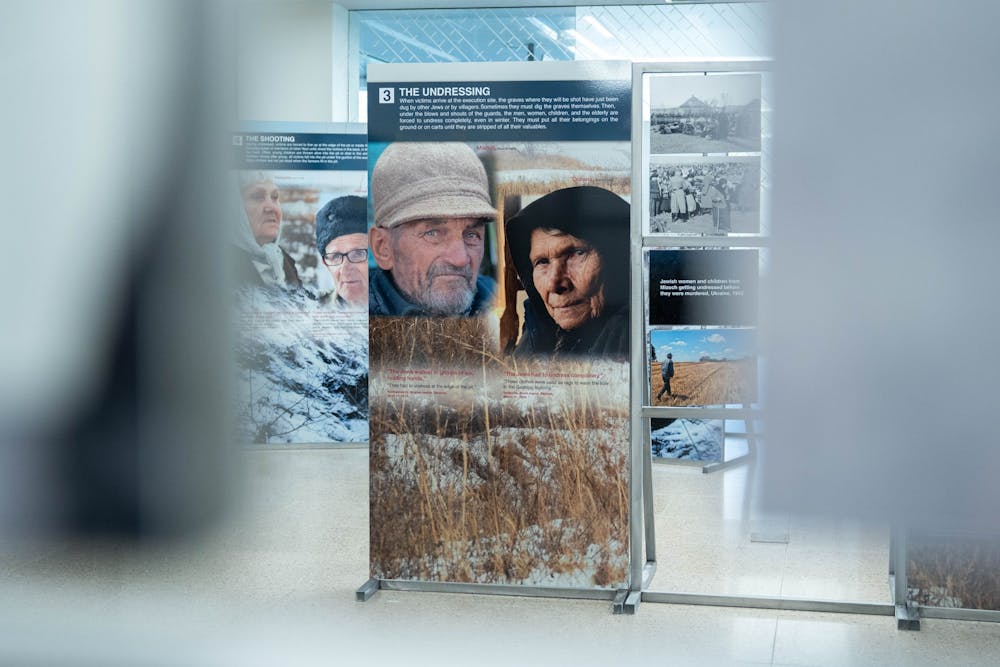Anyone who has walked through the north corridor on the first floor of the Hayden Library at any point in the last month has likely come across the powerful exhibit that is "Holocaust By Bullets."
The displays bring the events of The Holocaust to an unobscured understanding, making them not only impossible to deny but also frighteningly human.
This year, Holocaust Remembrance Day, also known as Yom Hashoah, falls on April 28. This day was chosen because the Warsaw Ghetto Uprising occurred during this time. In the United States, the Holocaust Remembrance Day runs for a week, starting on the Sunday before Yom Hashoah and ending on that next Sunday after Remembrance Day.
Most people are likely aware of the atrocities from World War II, like the infamous concentration camps or Kristallnacht, but the "Holocaust By Bullets" gets its name from a lesser known event — one that occurred in the very beginning of the war and hasn’t been as widely recognized.
During the 1941 Nazi invasion of the Soviet Union, over two million Jews and Roma were murdered in mass shootings throughout Eastern Europe by German mobile killing units.
According to the website for the exhibit, "this method of extermination has come to be known as the 'Holocaust by bullets' or 'genocide by mass shooting.'"
The exhibit features testimonials from both victims and witnesses of the genocide, as well as startling images of the mass shootings taking place. The displays evoke powerful feelings of empathy as well as an educating sense of awareness in its viewers.
"It’s important to acknowledge the scale of these atrocities," said Toby Harper, an assistant professor in the School of Historical, Philosophical and Religious Studies who took a class on a tour of the exhibit. "It’s about the mass murder of millions of people, but it’s also about individual people murdering other individuals."
The exhibit urged viewers to reflect on how mass murders like the "Holocaust by Bullets" could be prevented.
"I’m perplexed by how history could repeat itself with as much education as we receive about these events," said Christian Nicholas, an undergraduate student studying history who visited the exhibit. "We have power, it’s a matter of bringing it to light in the media and educating the public. It’s going to take years to achieve but it’s not impossible."
Despite its unsettling scale, the "Holocaust by Bullets" hasn’t been as widely studied as other events of the Holocaust because, up until recently, there was little mainstream education about the mass shootings.
It’s in part because of French priest Father Patrick Desbois and his extensive field research conducted throughout Eastern Europe that we know of “Holocaust By Bullets” in a fuller light.
In 2003, Desbois traveled to Ukraine to see where his grandfather was once imprisoned as a French POW during World War II.
It amazed Desbois there weren’t any memorials for the victims of the Holocaust in Ukraine, and there were no markings of the sites where the mass murders occurred.
He founded Yahad — In Unum (“together as one”) in 2004and began interviewing local witnesses of the mass shootings of Jews that occurred during Operation Barbarossa.
Although at first reluctant from being riddled with guilt, witnesses eventually opened up to the priest on their experiences and what they saw occur during the genocide. From the accounts he gathered, Desbois wrote two books on what happened in 1941.
The first book was published in 2008 and is titled "The Holocaust by Bullets: A Priest’s Journey to Uncover the Truth Behind the Murder of 1.5 Million Jews."
Through his work, Desbois has further educated audiences on these lesser known events of the Holocaust through extensive research, speaking tours and the creation of memorials for Holocaust victims in Eastern European countries that previously had none.
Without his efforts, the "Holocaust by Bullets" would not be as widely recognized as it is today.
"It's important to study the Holocaust because especially now, the generation of Holocaust survivors are unfortunately passing away and we don’t have many linking remnants of the Holocaust anymore, so we need to make sure that we keep that memory alive," said Jake Shulman, engagement associate at Hillel Jewish Student Center at ASU.
Shulman said he was grateful for the awareness the exhibit brought.
"I’d like to thank the Phoenix Holocaust Association for creating this exhibit and allowing us to experience it in a meaningful way, and for giving the Arizona State University community the opportunity to learn about this part of the Holocaust and continuing to share the stories of those affected," he said.
Desbois will speak on April 4 at the Memorial Union on the Tempe campus. The event is free and accessible in person or virtually through a livestream.
The Phoenix Holocaust Association’s “Holocaust by Bullets” exhibit will be open until April 8, with guided tours available on a rolling basis.
Editor’s Note: “Holocaust By Bullets” is a paid advertiser through ASU Student Media, which oversees advertising for The State Press. No members involved with the exhibit influenced the editorial or reporting process.
Reach the reporter at dmendrzy@asu.edu and follow @D3V0NWard on Twitter.
Like The State Press on Facebook and follow @statepress on Twitter.





